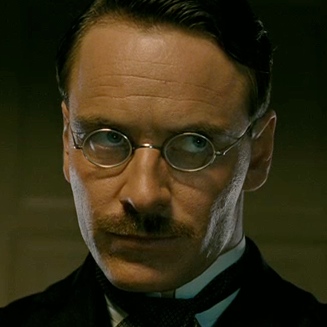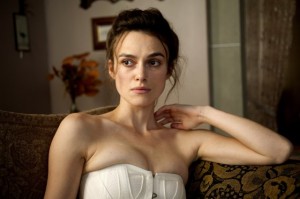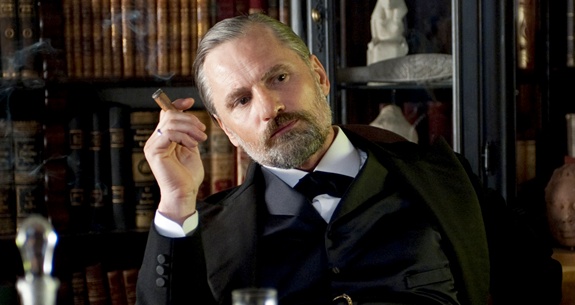Movie Review: Of Vice and Men — “A Dangerous Method”
“A Dangerous Method” fits neatly into director David Cronenberg’s body of work, which is often obsessed with a body-mind connection.
A Dangerous Method. Directed by David Cronenberg. Showings at selected screens in New England.
By Tim Jackson
David Cronenberg’s A Dangerous Method begins with a horse-drawn coach careening along a country road accompanied by a lively Howard Shore score. It’s 1904 and 19-year-old Sabina Spielrein, played by Keira Knightley, arrives in a fit of hysteria at the Burgholzli Clinic, a psychiatric hospital at the University of Zürich. The nurses carry her off, restrained, and the next day she begins a series of treatments with psychologist Carl Jung (Michael Fassbender). A rousing “action” opening, and the film manages to stay interesting enough, though the narrative is driven mostly by conversations and letters. The screenplay by Christopher Hampton from his play The Talking Cure is a remarkable story of sexual intrigue as well as an enlightening history of the early ideas in psychoanalysis and analytical psychology.
At the clinic, Jung uses Freud’s new talking cure to treat Spielrein, and uncovers disturbing psychosexual issues, such as her fixation on food and feces. These obsessions, with their fusion of pleasure and pain, are also most likely rooted in the status of women in the Victorian Age. Hysteria, known as the “disease of nuns, virgins, and old maids,” was a common diagnosis for women at the time. (Sarah Ruh’s wonderful play The Other Room, or the Vibrator Play deals with the then common treatments for female hysteria in a way you can surmise from the title.) Jung’s records suggest the conjunction of the personal and the political:
Patient loves her father painfully. She cannot turn to her father, he does not really understand her, he says hurtful things to her . . . He has hit [patient] several times on her bare buttocks and she has had to kiss his hand in return. It gradually emerges that he has hit her several times on her bare buttocks, most recently in her 11th year, from time to time in front of her siblings. It takes a powerful battle to get her to make these confessions. At this point [her] tics . . . express abhorrence and revulsion.
Sabina, a highly intelligent woman from a wealthy Russian family, has ambitions of her own to become a psychologist. Jung eventually asks her to work with him as his assistant.
In 1909 Jung heads to Vienna to meet with Sigmund Freud, the guru of modern psychoanalysis. As Freud, Viggo Mortensen sports a trim beard, sharp suits, and an ever-present cigar in a muted performance that represents a radical shift from his earlier Cronenberg films. He was an ex-hitman, family man in History of Violence and a tattooed Russian mobster in Eastern Promises. What connects his approach to all these roles is a focused and cool intelligence. At the turn of the century, Freud was reviled by some and revered by others; his methods were beginning to change the face of psychology and the treatment of nervous disorders. Freud, 19 years older than Jung, asks the young doctor to see one of his patients, a fellow physician and free thinker named Otto Gross (Vincent Cassal). John Kerr, in his book A Most Dangerous Method, explains that Gross believed that in Freud’s principles there lay “a practical method for cultural revolution . . . a world where monogamy did not exist, where all patriarchal authority had been overthrown, and where communal living and self-exploration would guide each individual to his own artistic heights.”
Jung, already attracted to Spielrein, begins an affair with her, playing out her masochistic fantasies. He administers the spankings with a cool detachment that seem more therapeutic than erotic, perhaps the rationalization of his wish to create a “cultural revolution.” Yet despite psychotherapy’s claim to be a science, Jung’s ethical degradation, with its for hunger for power over another, is obvious. Jung is married and his wife is expecting.
Freud and Spielrein were Jewish, Jung a gentile; this tragically complicates the trio’s history and intrigue, given that within a few decades civilization would be ripped apart by the First World War and Hitler would come to power. Beyond the scandal with Jung, Spielrein was one of the first women to undergo psychoanalysis, her early diagnosis leading to a successful career as a psychoanalyst. She later brought psychoanalysis to Russia, though Spielrein was pretty well unknown until her papers were discovered in 1977. She was part of Jung’s Freudian period and was with him during his falling out with Freud, whose scientific determinism and fixation on sexuality clashed with the mystical leanings of Jung’s more transcendental emphasis on mythology and archetypes. Spielrein was an influence on both Freud and Jung—each references her in his own papers. Still, many believe she did not receive just intellectual credit for her ideas.
The surprising twists and turns of A Dangerous Method seem too outrageous to be true, but most are based on documented fact. As a film, however, it is distanced to a fault. Beyond all the interesting conversation, the audience needs to see and feel the life in these characters. Theater, being a medium for language, may be more suitable for the extensive dialogue required for the exposition and arguments over abstract issues. At times A Dangerous Method feels contrived to the point where there are laughs where you would least expect. Nevertheless, it is beautifully shot, and though the conflicts are at times painted with too obvious a brush, they compel.
The movie also fits neatly into Cronenberg’s body of work, which is often obsessed with a body-mind connection. His early films emphasized physical horror, particularly bizarre manifestations and transformations of the flesh. He has moved far from the murderous Id-driven baby demons hatched by Samantha Eggar in his second film, The Brood. A Dangerous Method refines the mind/body discussion to a reality-based examination of some little known historical facts about two increasingly dissected giants of modern thought. Freudian psychoanalytic theory has diminished in relevance in the last few decades; interest is now focused on the troubled personalities of Freud and his followers. Meanwhile, curiosity about mythology (Joseph Campbell), yoga, and other “new age” practices has grown and they have become increasingly popular, though perhaps in ways that Jung would not have sanctioned. In this tale of male “healers” who end up exploiting women in the cause of liberating them is apt exploration of unintended consequences.
Further reading on the subject:
A Dangerous Method (Movie Tie-in Edition): The Story of Jung, Freud, and Sabina Spielrein by John Kerr
The Talking Cure by Christopher Hampton
Sabina Spielrein: Forgotten Pioneer of Psychoanalysis by Coline Covington and Barbara Wharton
Jung’s Analysis of Sabina Spielrein and his use of Freud’s free association methods by Alex Hoffer (online PDF)
Tagged: A Dangerous Method, Carl Jung, Christopher Hampton, David Cronenberg, Sigmund Freud



